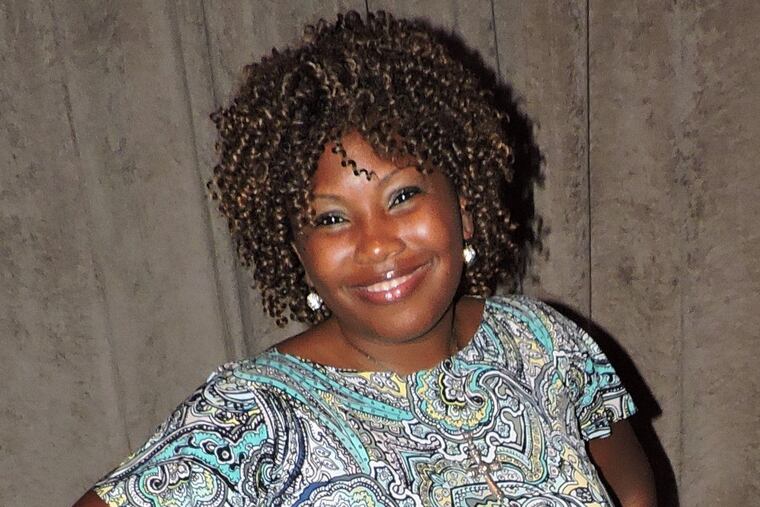Newly approved sickle-cell drug ushers in an era of therapeutic breakthroughs
The key to managing sickle cell patients’ chronic pain has been far from ideal: prescription opioids. At last, a new drug offers a new approach.

Terri Booker’s worst sickle-cell crisis almost killed her.
Her sticky, stiff, crescent-shaped red blood cells formed a blockage in her bloodstream, starving her of oxygen, triggering unbearable pain, and sending her, at 20 years old, into kidney and lung failure.
Now 36, the Philadelphia lawyer is thrilled by the U.S. Food and Drug Administration’s approval this month of Novartis’ sickle-cell drug Adakveo, a monthly intravenous infusion for patients over age 15 that has been shown to dramatically reduce vessel-obstruction crises and hospitalizations.
The new drug, which targets a specific protein involved in cell stickiness, is part of a wave of novel therapies that could transform the outlook for patients with the devastating illness, the most common inherited blood disorder. In February, the FDA is expected to approve Global Blood Therapeutics’ daily pill Voxelotor, which treats the underlying cause by helping to prevent red blood cells from deforming.
More than 30 other therapies are in development, including some that may offer a cure by repairing the genetic mutation that hinders hemoglobin’s ability to carry oxygen — the defect that causes red blood cells to sickle. Just last week, Vertex Pharmaceuticals and CRISPR Therapeutics announced that the first treatment made with genetically edited cells is producing a crucial protein in the inaugural sickle-cell patient, four months after her infusion.
“I’m actually excited for the future of sickle-cell treatment,” Booker said. “Not only treatments but cures are in the pipeline."
» READ MORE: Sickle cell patients, families, and doctors face a 'fight for everything'
That optimism was echoed by Alexis A. Thompson, head of hematology at Lurie Children’s Hospital of Chicago.
“For such a challenging disease, we have had so few tools to treat it,” said Thompson, past president of the American Society of Hematology. Adakveo “is terribly exciting. It represents not just an additional tool, but one that was designed specifically for sickle-cell disease. These new agents moving toward approval address the disease process in a rational way.”
An estimated 100,000 Americans, most of them African American, have sickle-cell disease, including about 3,000 in the Delaware Valley. Worldwide, millions are affected.
For decades, doctors could give them nothing more than symptom relief using blood transfusions, painkilling opioids, and hydroxyurea, a drug that increases the hemoglobin in red blood cells. Developed as a cancer drug, hydroxyurea was approved for sickle-cell disease in 1998. Almost two decades passed before a second drug, Endari, an amino acid that reduces oxidative stress on deformed cells, was approved in 2016.
» READ MORE: Q&A: A family member was recently diagnosed with sickle-cell disease. What should I know?
Despite limited treatments, improvements in medical care have lengthened patients’ lifespan to about 50 years.
“This used to be a pediatric disease because patients didn’t survive into adulthood,” said David J. Axelrod, the physician who co-directs the sickle-cell program at Jefferson University Hospitals. “Now it’s more of a chronic disease, so patients are dying from end-stage organ disease."
Living with the disorder is a constant struggle. Zemoria Brandon sees it every day as an administrator and social worker with the Philadelphia-Delaware chapter of the Sickle Cell Disease Association of America, cofounded by her husband, who died in 1998.
“We have children on morphine to relieve their pain,” Brandon said. “We’ve had children who have had strokes.”
Like others, Brandon is happy about Adakveo, which cut the rate of obstructed-vessel crises by nearly half to 1.63 episodes a year, compared with 2.98 a year for patients on a placebo.
“But,” Brandon added, “we’re hoping that a universal cure is on the horizon.”
The only proven cure for children with the disease is a stem-cell transplant from a tissue-matched sibling. The risky procedure — which destroys the patient’s own immune system, then restores it using the donor’s cells — is an option for only about 10% of children because matched siblings are so rare.
Recently, however, researchers have begun to expand the pool of eligible patients by using less perfectly matched donor stem cells, along with techniques that enrich the transplanted cells and reduce the chances of infection and rejection. Even adults have been successfully treated.
“The toxicity of the transplant used to be too much for adults. There was 100% mortality,” said Thompson at Lurie Children’s Hospital. “We’ve identified ways to minimize the risks.”
Another promising approach involves gene therapy — using an inactivated virus to ferry a corrective gene into the patient’s cells. Bluebird bio’s experimental gene therapy LentiGlobin adds a gene that can enable patients to make healthy red blood cells, with the goal of replacing sickled cells as they die off. Early results from a small group of patients are encouraging.
Cost, as always, is a looming issue. Novartis said Adakveo will be priced at $2,357 per vial, so a year’s treatment would cost between about $84,000 and $113,000.
Booker has personal experience with the cost barrier. She wanted to try Endari, but couldn’t afford the $300 monthly co-pay. She applied to Emmaus Medical Inc.'s financial assistance program and recently began taking the company’s drug.
“I do keep abreast of research. I need to because sometimes even doctors don’t know what’s going on,” Booker said. "I worry that these new drugs will be too expensive for patients to afford or, worse, they won’t know about them.”